ad-MED Vitrigel ™ 2
ad-MED Vitrigel™ 2 is a cell culture insert using a collagen Vitrigel™ membrane as a scaffold for cell culturing. ad-MED Vitrigel™ 2 indicates high adhesive property against various kind of animal cells. Also, it is useful for fabrication of three- dimensional tissue models appropriate for drugs and cosmetics development. Recently, it’s considered as a material for MPS devices as well, and it’s a product with high potential.
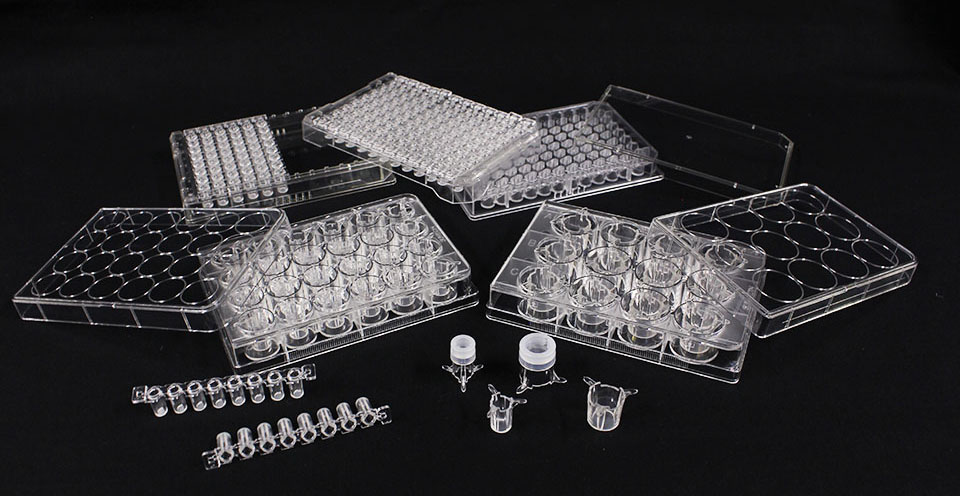
Vitrigel™ is a registered trademark of National Agriculture and Food Research Organization (NARO).
This product is supported by Agri-Health Translational Research Project from the Ministry of Agriculture,Foresty and Fisheries of Japan.
Collagen Vitrigel™
When the moisture of the collagen gel is removed, the collagen fiber density increases and the collagen gel turns into a film. Because this dehydration process is called “Vitrification”, the film produced by this method is called “Vitrigel™ ”.
Features
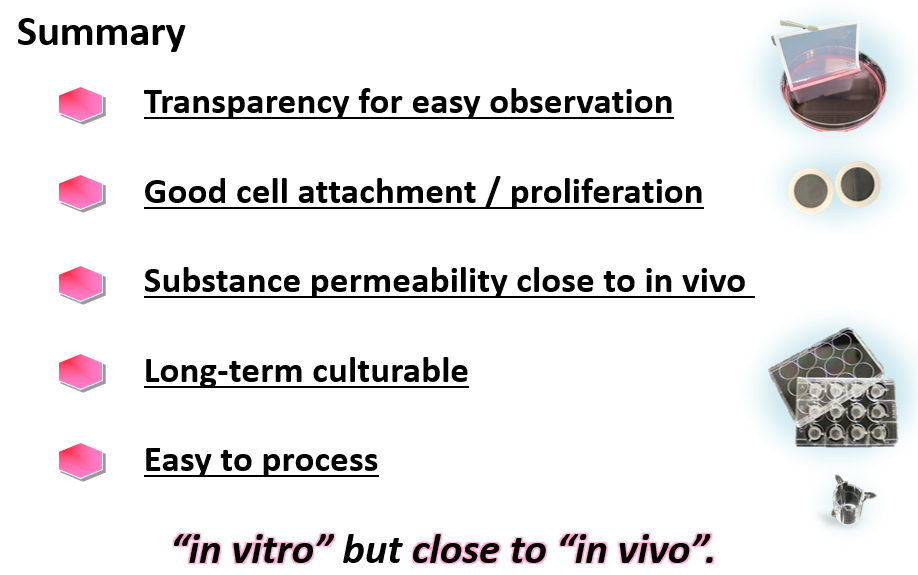
Excellent visibility for observation
These images indicate transparency of each membranes. Each cell culture inserts were placed on the black cloth after rehydration with PBS. Transparency of collagen Vitrigel™ membrane is higher than that of PET or PTFE membrane. Collagen Vitrigel™ membrane is low fluorescent membrane. It makes high-contrast fluorescent observation.

High adhesive property / Promotion of cell spreading
ad-MED Vitrigel™ 2 indicate excellent cell adhesive property and proliferation acitivity as compare to other cell culture inserts using plastic membrane.
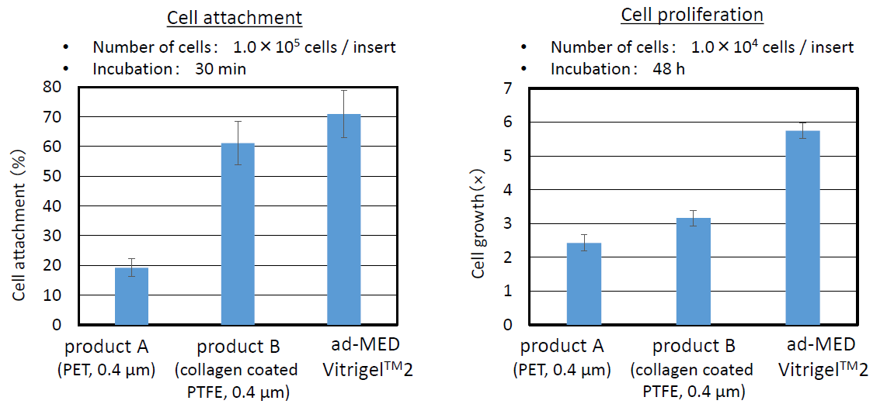
Permeability
FITC-dextran (MW:4,000 or 10,000 or 40,000) was used as a permeable substance.These results suggested that the permeability of collagen vitrigel membrane was higher than that of PET (0.4 μm) membrane and dependent on the molecular weight of a substance unlike the PET membrane.

Long-term culture
The Vitrigel™ culture method can maintain CYP metabolic activities for at least 3 weeks.

*this data is cited by ChemTime 266 B
Designs for easier handling

Appropriate for constructing co-culture systems
ad-MED Vitrigel™ 2 allow to co-culture different type of cells on both inner and outer side of collagen Vitrigel™ membrane by using option ring.
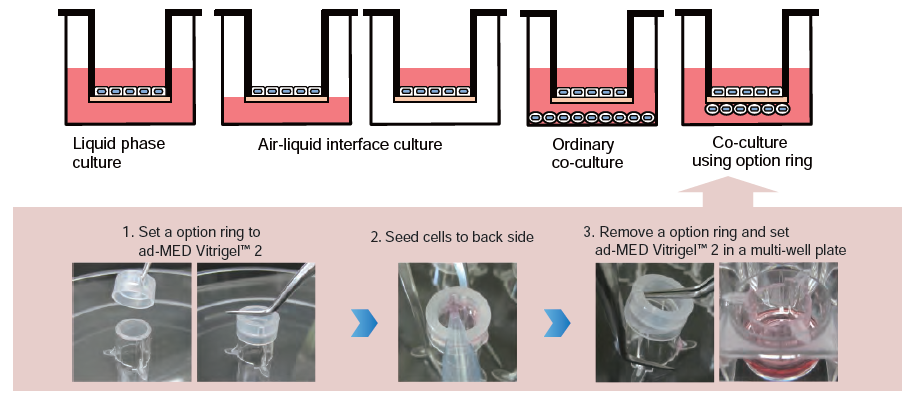
Collagen Vitrigel™ 2 membrane
We also supply Vitrigel™ in processable membrane form in 12 well or 24 well size.
Custom-made products are also available, please contact us.

Product lineup
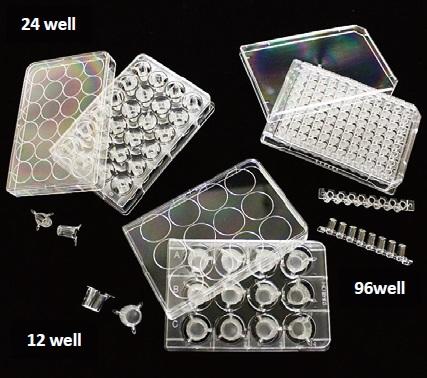
| Product No. |
Product Name |
Grade |
Size |
| 08363-96 |
ad-MED Vitrigel™ 2 (12 well) |
for cell culture |
12 pieces/set |
| 08364-96 |
ad-MED Vitrigel™ 2 (24 well) |
for cell culture |
24 pieces/set |
| 08368-96 |
ad-MED Vitrigel™ 2 (96 well) |
for cell culture |
96 well/set |
| 44125-67 |
Vitrigel™ 2 Membrane (φ15 ㎜), sterlie |
for cell culture |
1 pack (24 sheets) |
| 44125-67 |
Vitrigel™ 2 Membrane (φ21 ㎜), sterlie |
for cell culture |
1 pack (24 sheets) |
| 08369-96 |
Option Ring for ad-MED Vitrigel™ (12 well) |
for cell culture |
1 pack (24 pieces) |
| 08373-96 |
Option Ring for ad-MED Vitrigel™ (24 well) |
for cell culture |
1 pack (24 pieces) |
|
brochure
ad-MED Vitrigel™ 2 series
References
Takezawa T. et al. J Toxicol Sci. 47: 39-50, 2022.
Morimoto Y. et al. Sensors and Actuators B: Chemical. 38: 130675, 2021.
Yoshida S. et al. Stem Cell Reports. 16: 295-308, 2021.
Uzu M. et al. J Pharmacol Toxicol Method. 106: 106916, 2020.
Shima A. et al. In Vitro Cell. Dev. Biol. Anim. 56: 500-504, 2020.
Ogaki A. et al. Neuropsychopharmacol Reports. 40: 307-313, 2020.
Moriyama M. et al. Scientific Reports. 9: 18371, 2019.
Nakai S. et al. Biol Open. 8 (7): bio042192., 2019.
Watari R. et al. Biol. Pharm. Bull. 42: 348-353, 2019.
Yamaguchi H. et al. Drug Metab Dispos. 46: 1684-1691, 2018.
Watari R. et al. J Toxicol Sci. 43: 521-529, 2018.
Yamaguchi H. et al. Journal of Applied Toxicology. 36: 1025-1037, 2016.
Yamaguchi H. et al. Toxicol Sci. 135: 347-355, 2013.
Takezawa T. Journal of Biosciences and Bioengineering. 91: 214-217, 2013
Takezawa T. et al. Toxicol In Vitro. 25: 1237-1241, 2011.
Takezawa T. et al. Cell Transplant. 13: 463-473, 2004.













